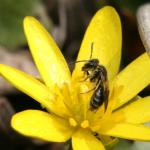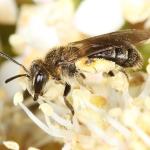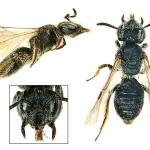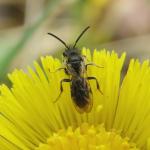This small bee exhibits seasonal dimorphism. Following a review of the British Micrandrena, Perkins (1914) considered that individuals of the spring generation were a distinct species, Andrena parvula (Kirby). He knew the summer generation as Andrena minutula (Kirby). The differences between the broods were based on very subtle differences in surface microsculpture and punctation. The name parvula was later demoted to that of a junior synonym of minutula (Perkins, 1919). This is a very common species but is easily overlooked and sometimes misidentified as the closely related species Andrena minutuloides Perkins and Andrena semilaevis Pérez.
This is perhaps the most frequently encountered species of the subgenus Micrandrena in the British Isles. The bee is widely distributed throughout Britain from the south coast of England northwards to southern Scotland (Kirkcudbrightshire). The species was recorded for the first time in the Isle of Man as recently as 2009 (S M Crellin, pers. comm.). It is sporadic in Ireland, with records from Kilkenny, Carlow, Wicklow and Dublin (Stelfox, 1927). On the Channel Islands it occurs on Jersey, Herm and Guernsey (Richards, 1979; Archer, 1996); also Sark (Beavis, 2000).
The species is very widely distributed in the Palaearctic region, the range extending from southern Fennoscandia (though very rare in Finland) south to Spain and North Africa (Morocco to Tunisia), and east to Turkey and the former USSR (Gusenleitner & Schwarz, 2002). It is additionally known from Pakistan (Quetta), China and Japan (Tadauchi, 1985). Gusenleitner & Schwarz (2002) recognise four subspecies of which only the nominate one occurs in the British Isles and Channel Islands.
This species is not regarded as scarce or threatened.
Generally distributed, occurring for example in open woodland, grassland, coastal sites and in gardens.
Bivoltine; the spring brood flies from mid March to early June, the summer one from late June or early July to the end of September.
Despite the local abundance of this bee, its nests are not often found. In mainland Europe it is reported to nest solitarily (Dylewska, 1987) and the same behaviour may exist in the Britain and the Channel Islands.
Both broods visit the flowers of many species.
Several authors regard this bee as being the host of the common cleptoparasitic bee Nomada flavoguttata (Kirby) (e.g. Perkins, 1919; Westrich, 1989). Individual bees are sometimes stylopised by Stylops spreta Perkins (Strepsiptera).
2016





